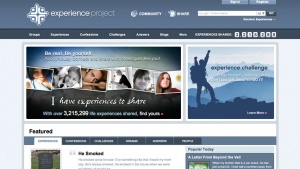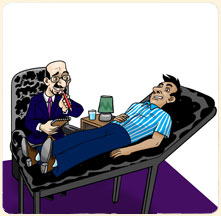Difference between revisions of "Experience Project"
(→The case of anonymity) |
(→Interface) |
||
| Line 14: | Line 14: | ||
== Interface == | == Interface == | ||
| − | + | [[File:Epinterface.jpg|300px|thumb|Outlook]] | |
The interface is reasonably simple and gives the users a lot of options to choose from. Majority of the home screen is occupied by a list or preview of some of the featured stories. Each story is followed by a brief, two line summary of what the post is about, so you can get a fair idea of the topic and can jump into an interesting discussion immediately, without going through a long list of stories. Two generic indices called ‘categories’ and ‘sections’ are located in one corner of the home page, which can navigate you to a list of places depending on your mood. ‘Categories’ contains topics like arts and entertainment, culture, religion, current events, and food. Users can pick a category to see a host of stories related to that specific category and may comment on one if it interests them. ‘Sections’ allows you to explore other places such as question/answer sessions, confession stories, and also see a list of active users on the website. You can decide to interact with a user by sending them a virtual gift or a greeting card or by messaging them. Another unique section is the “daily question” section. Every day a new question is published here and users are invited to share their opinions on a particular topic. There is also some space allocated for advertising. | The interface is reasonably simple and gives the users a lot of options to choose from. Majority of the home screen is occupied by a list or preview of some of the featured stories. Each story is followed by a brief, two line summary of what the post is about, so you can get a fair idea of the topic and can jump into an interesting discussion immediately, without going through a long list of stories. Two generic indices called ‘categories’ and ‘sections’ are located in one corner of the home page, which can navigate you to a list of places depending on your mood. ‘Categories’ contains topics like arts and entertainment, culture, religion, current events, and food. Users can pick a category to see a host of stories related to that specific category and may comment on one if it interests them. ‘Sections’ allows you to explore other places such as question/answer sessions, confession stories, and also see a list of active users on the website. You can decide to interact with a user by sending them a virtual gift or a greeting card or by messaging them. Another unique section is the “daily question” section. Every day a new question is published here and users are invited to share their opinions on a particular topic. There is also some space allocated for advertising. | ||
Revision as of 08:07, 18 December 2011
Experience Project is a free social networking platform that allows people to connect with each other by sharing life experiences and stories. It is a community where users can share their experiences with others by writing their personal stories, posting photos, videos, and blogs. The network encourages anonymity so that people do not feel afraid of being recognized or embarrassed while sharing their stories. The network’s slogan reads: “real life, real people, real stories”, which underlines an open and genuine storytelling experience. As of January 2011, the site held almost 7 million experiences[1]Contents
History
Experience Project was started by Armen Berjikly in 2004, originally as a site dedicated to MS patients, with a goal of connecting those going through the horrific experience. As Berjikly interacted on the site, he realized that what made it so popular was the connections and bonds formed between individuals. This caused the site to become the Experience Project and it was introduced to the general public in October 2006. The website is headed by Berjikly and an executive board including Neil Sheth and Julio Vasconcellos. As of 2011, there are about 9.5 million registered users and the website is continuing to expand. The Experience Project also provides support group resources for users, along with causes and petitions for people who feel that they should be proactive about their life experiences or the life experiences of others.
Goal
The aim of this network is to share positive and negative life experiences and find other people with similar stories. It gives users a chance to realize that they are not the only one going through a specific crisis. The feedback system allows one to see that there are many people experiencing similar pressures. Community members create groups around personally significant life experiences. Members can join groups based on location or interests, sharing and reading different stories. Users do not have to be permanent members to use this website. Anyone who visits the website can post a story, or take part in a discussion about someone's story. Some examples of stories include depression issues, problems of divorce, and sexual assaults. Like other social networks, Experience Project allows users to make friends by linking them with people of common experiences. Users can blog on the website, play games, make confessions, take surveys, and join and support their favorite causes. Users can also listen to their favorite songs by using a special search engine that matches users’ moods to songs. The entire purpose of the Experience Project is to gain a greater understanding of other users' experiences, while still maintaining anonymity.
Interface
The interface is reasonably simple and gives the users a lot of options to choose from. Majority of the home screen is occupied by a list or preview of some of the featured stories. Each story is followed by a brief, two line summary of what the post is about, so you can get a fair idea of the topic and can jump into an interesting discussion immediately, without going through a long list of stories. Two generic indices called ‘categories’ and ‘sections’ are located in one corner of the home page, which can navigate you to a list of places depending on your mood. ‘Categories’ contains topics like arts and entertainment, culture, religion, current events, and food. Users can pick a category to see a host of stories related to that specific category and may comment on one if it interests them. ‘Sections’ allows you to explore other places such as question/answer sessions, confession stories, and also see a list of active users on the website. You can decide to interact with a user by sending them a virtual gift or a greeting card or by messaging them. Another unique section is the “daily question” section. Every day a new question is published here and users are invited to share their opinions on a particular topic. There is also some space allocated for advertising.
Ethical Concerns
The case of anonymity
Proponents of the website argue that anonymity is an important aspect of Experience Project. There are several advantages of such a setup, but there may also be some drawbacks. Upon registration, the system asks you if you want your profile to be social or discreet. This primarily means that you can choose to reveal your identity or remain anonymous. The site, itself promotes anonymity because it is thought that users feel more comfortable talking about their lives when other people cannot recognize them. The argument is: can such anonymity be constructive?
Usually, social networks allow you to establish your own identity and promote yourself online, which means you have the opportunity to connect with others by your name. On the contrary, Experience Project allows you to connect with others through your experiences [2] . A stage like this represents a constructive environment in the sense that it seeks to identify you as a person with a unique experience. This means if you have a unique story, you are a unique member. On other social networks, where your identity is not hidden, a negative experience classifies you into a judgmental category. People start remembering you for your tragedy or your illness. But, on this network, such a judgmental phase is totally avoided [2]
Sometimes you don’t go to your friends for help because you don’t want them to know your problems. Experience Project allows you to find help without allowing others to recognize you. On this network, you can vent out your feelings by writing your thoughts while having the choice to preserve your identity. A recent user said:
"Once I write it, it’s gone.”
She describes that writing acts as a form of therapy and helps her to express her unspoken feelings [2]. It lifts a burden off her shoulders. So then, in such a scenario should we argue to stop anonymity?
It seems that anonymity works perfectly in this environment, but there are a few downsides attached. In some cases, some anonymous users have used the website to make fun of some of the published stories. Some people have created fake profiles to join groups and provide negative responses to people. This kills the purpose of the entire network.
On a different note, some people argue that this network, and many other similar networks, are developed as money making schemes. People who join the community are narrated sad stories and are in turn pressurized to donate to charities. Such a motive clearly defeats the concept of constructive storytelling and open communication.
References
- ↑ http://en.wikipedia.org/wiki/Experience_Project
- ↑ 2.0 2.1 2.2 David Spark (2009) Anonymous social networks open the gates for digital therapy


